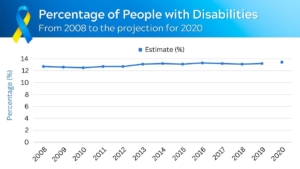SECURE Act 2.0 Includes New Provision On Special Needs Trusts

Experts estimate there are more than 44 million people with disabilities in the U.S., representing 13.4% of the population.1
Many parents of children with disabilities choose to establish a special needs trust. This can help provide financial support for the child long after the parents or guardian has passed away. The passage of the SECURE Act in 2019 added complexity to how these types of trusts could be set up, resulting in some limitations regarding how they could be used as long-term financial solutions. However, the SECURE 2.0 Act included a modification to help rectify this situation.
It’s important to remember that using a trust involves a complex set of tax rules and regulations. When we help clients who are interested in a trust, we work with professionals who are familiar with the emerging rules and regulations.
The SECURE Act
The SECURE Act was hailed as the most substantial retirement legislation passed in over a decade. It contained important changes to individual retirement accounts (IRAs) and other qualified accounts intended to help investors save more and be better prepared for the future. Some of the more popular provisions of the Act raised the required minimum distribution (RMD) age, allowed first-time parents to take penalty-free withdrawals from their retirement accounts in certain instances, and removed the age limit for traditional IRA contributions if you have earned income.1
The SECURE Act also made significant changes to inherited IRAs by requiring beneficiaries to draw down their inherited IRA within 10 years after the IRA creator’s death. Lawmakers carved out exceptions to this rule for beneficiaries who are spouses, are minor children, or are experiencing disabilities.2
It’s important to note that once you reach age 73, you must begin taking RMDs from a traditional IRA in most circumstances. Withdrawals from traditional IRAs are taxed as ordinary income and, if taken before the age of 59½, may be subject to a 10% federal income tax penalty.
SECURE 2.0
Although much of the SECURE ACT was well received, some unintended consequences and missed opportunities needed addressing. The SECURE 2.0 Act was signed on December 29, 2022, and included 92 new, modified, or clarified provisions to the original. One of these changes pertained to special needs trusts.3
Charities Are now Allowed to be Remaindermen of a Special Needs Trust
SECURE 2.0 resolved an issue with the SECURE Act and clarified that, in the case of a special needs trust established for a beneficiary with a disability, the trust may provide for a charitable organization as the remaining beneficiary without triggering the truncated payout period. This change offered a welcome, though limited, enhancement to special needs trusts designed to receive retirement benefits and qualify as see-through trusts under the SECURE Act provision for applicable multi-beneficiary trusts (AMBTs).3,4
Although this provision allowed most charities to be named as remainder beneficiaries after the death of a disabled or chronically ill beneficiary—without disqualifying that initial disabled beneficiary from stretching the IRA over their lifetime—grantors must be careful to avoid naming disqualified charities such as private foundations as the remainder beneficiary.4
Special Needs Trusts5
A special needs trust is a legal arrangement that allows a disabled or chronically ill person to receive income without reducing their eligibility for the public assistance disability benefits provided by Social Security, Supplemental Security Income, or Medicaid.
A grantor, such as a parent or guardian, creates a special needs trust and appoints a trustee to oversee the disbursement of assets from the trust to the disabled beneficiary. The trust is designed to supplement the beneficiary’s government benefits but not replace them.
A special needs trust is one strategy for those who want to help someone in need. The trust seeks to manage the risk that the person will lose their eligibility for government programs that require income or assets to remain below a certain limit.5
Many grantors will set up a special needs trust that names a charity as the remaining beneficiary in the event the original beneficiary dies before the funds are depleted. SECURE 2.0 now allows that practice to continue.
We Can Help
If you are currently caring for a child experiencing a disability or know someone who is, one consideration may be a special needs trust.
As financial professionals, we can provide some insights into how a trust works, and we can help you access more information that addresses specific needs. We also can help explain your financial situation if you choose to start working with an attorney to create a special needs trust.
It’s never too early to start a conversation on how your loved ones–especially those experiencing disabilities–can benefit from your care and financial legacy. Whether you’re a current client or considering working with a financial professional, don’t hesitate to reach out.
- DisabilityCompendium.org, 2021
https://disabilitycompendium.org/sites/default/files/user-uploads/Events/2022ReleaseYear/Annual%20Report%20—%202021%20—%20WEB.pdf - Kiplinger.com, April 21, 2022
https://www.kiplinger.com/retirement/inheritance/604567/if-you-inherited-an-ira-recently-you-could-be-in-for-a-mess#:~:text=The%20SECURE%20Act%20made%20major%20changes%20by%20requiring,of%20beneficiaries%2C%20such%20as%20spouses%20and%20minor%20children - Business.BOFA.com, December 2023
https://business.bofa.com/content/dam/flagship/workplace-benefits/id20_0905/documents/understanding-SECURE-act-2022.pdf - UltimateEstatePlanner.com, August 1, 2023
https://ultimateestateplanner.com/2023/08/01/secure-2-0-act-enhances-special-needs-see-through-trust-planning/ - Investopedia.com, July 12, 2022
https://www.investopedia.com/terms/s/special-needs-trust.asp

 Client Login
Client Login





Leave a Reply
Want to join the discussion?Feel free to contribute!